Port Jefferson, New York
Port Jefferson (informally known as Port Jeff[4]) is an incorporated village in the Town of Brookhaven in Suffolk County, New York on the North Shore of Long Island. Officially known as the Incorporated Village of Port Jefferson, the population was 7,750 as of the 2010 United States Census.[5]
Port Jefferson, New York | |
|---|---|
Village | |
| Incorporated Village of Port Jefferson | |
 Clockwise from top: a view of shops on Main Street, monument commemorating the village's maritime past, Port Jefferson Village Hall, A ferry passes a local power plant en route to Bridgeport, Connecticut, Port Jefferson Free Library | |
| Nickname(s): Port Jeff | |
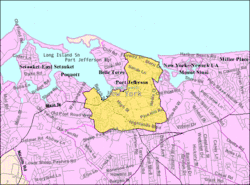 U.S. Census Map | |
 Port Jefferson Location within the state of New York | |
| Coordinates: 40°56′46″N 73°3′44″W | |
| Country | |
| State | |
| County | Suffolk |
| Government | |
| • Type | Mayor-Council |
| • Mayor | Margot Garant |
| Area | |
| • Total | 3.09 sq mi (8.00 km2) |
| • Land | 3.06 sq mi (7.93 km2) |
| • Water | 0.03 sq mi (0.07 km2) |
| Elevation | 12 ft (4 m) |
| Population | |
| • Total | 7,750 |
| • Estimate (2019)[3] | 8,145 |
| • Density | 2,659.16/sq mi (1,026.61/km2) |
| Time zone | UTC−05:00 (Eastern (EST)) |
| • Summer (DST) | UTC−04:00 (EDT) |
| ZIP Code | 11777 |
| Area code(s) | 631 |
| FIPS code | 36-59355 |
| GNIS feature ID | 0960968 |
| Website | www |
Port Jefferson was first settled in the 17th century and remained a rural community until its development as an active shipbuilding center in the mid-19th century. The village has since transitioned to a tourist-based economy. The port remains active as terminus of the Bridgeport & Port Jefferson Ferry, one of two commercial ferry lines between Long Island and Connecticut, and is supplemented by the terminus of the Long Island Rail Road's Port Jefferson Branch. It is also the center of the Greater Port Jefferson region of northwestern Brookhaven, serving as the cultural, commercial and transportation hub of the neighboring Port Jefferson Station, Belle Terre, Mount Sinai, Miller Place, Poquott, and the Setaukets.
History
Colonial and precolonial history
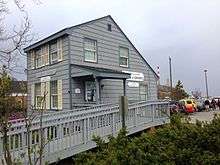
The original settlers of the Town of Brookhaven, based in the neighboring hamlet of Setauket, bought a tract of land from the Setalcott Indians in 1655. The deed included the area of contemporary Port Jefferson along with all other lands along the North Shore from the Nissequogue River eastward to Mount Misery Point.[6]
Port Jefferson's original name was Sowasset, a Native American term for either "place of small pines" or "where water opens.[7]
The first known home within the present village boundaries was erected in the early 1660s by Captain John Scott, an important leader in Long Island's early history. This house, named Egerton, was a grand abode on the western end of Mount Sinai Harbor at Mount Misery Neck.[8] The first settler in Port Jefferson's current downtown was an Irish Protestant shoemaker from Queens named John Roe, who built his still-standing home in 1682. It remained a small community of five homes through the 18th century, and was renamed to "Drowned Meadow" in 1682.[6]
Local lore has it that the pirate Captain Kidd rendezvoused in the harbor on his way to bury treasure at Gardiner's Island.[9] During the Revolutionary War, and that John Paul Jones had a ship fitted here.[9] However, there is no factual support for these assertions, and the historical works quoted do not present them as definitive facts. John Paul Jones' career in particular is well documented, and there are no accounts of him actually visiting the village which was under British control during the entire time he served as a commanding officer.
Development as a shipbuilding village
In 1797, when the town had but five houses, its first shipyard was built. By 1825, several shipbuilding firms existed, bringing in new residents and commerce.[9]
During the War of 1812, British interference on Long Island Sound upset local shipping routes. On one occasion, two British warships, the frigate H.M.S. Pomone and brig H.M.S. Despatch sent their boats into the harbor under cover of darkness and captured seven sloops.[10] To protect local interests, a small fortress was set up on the west side of Port Jefferson Harbor.[11]
It wasn't until 1836 that the local leadership truly initiated the community's transition from a swampish hamlet to a bustling port town. Twenty-two acres of the harborfront, which flooded with the tides, were brought to a stable elevation with the construction of a causeway. Concurrently, the village was rechristened from "Drowned Meadow" to "Port Jefferson"[12][13] The name choice was in honor of Thomas Jefferson.
Numerous shipyards developed along Port Jefferson's harbor and the village's shipbuilding industry became the largest in Suffolk County. A common misconception is the belief that the village was as a major whaling port. This is not supported by Government documents used to compile the two definitive references on the American Whale fishery. These two works list every vessel and every voyage undertaken by American whaling vessels from colonial days until the 1920s, none of which began or ended at Port Jefferson. However two whaling vessels were built for New Bedford at Port Jefferson in 1877 (ship Horatio and bark Fleetwing), and a Port Jefferson built schooner (La Ninfa) was later converted into a whaling vessel at San Francisco.[14][15] Port Jefferson's main role as a port in the 19th Century was to build and support vessels engaged in the coastal freighting trades. Many of Port Jefferson's remaining homes from this period were owned by shipbuilders and captains. This includes the Mather House Museum, a mid-19th century home once owned by the Mather shipbuilding family that now serves as the center of a museum complex and headquarters for The Historical Society of Greater Port Jefferson.
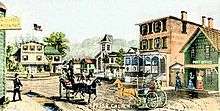
P. T. Barnum, the famous circus owner, owned a tract of land which ran through the village. His intention was to make Port Jefferson the home base for his circus. The residents put a stop to his plans, and he eventually sold his land. Barnum Avenue now runs through the area that was once his land, and one of the Bridgeport & Port Jefferson Ferry boats is named the P. T. Barnum. A house he had constructed also still exists but is privately owned.
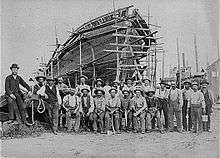
During this period, lower Port Jefferson's main section of commerce was located on what is now East Main Street. Most of the current Main Street, located on what was initially a swamp, did not become as commercially viable until the 20th century. The section of town at the intersection of the two streets, then known as Hotel Square, became an active center of Port Jefferson's early tourism industry in the mid-19th century. Visitors in town for business, or traveling through by rail or ship, were able to select from a variety of lively hotels and restaurants. This included the John Roe house, which was repurposed and expanded into the Townsend House hotel. The village's first post office was added to this intersection in 1855.[16]
With the 1923 sale of the Bayles Shipyard to the Standard Oil Company and demolition of all but two of its structures, Port Jefferson's shipbuilding industry came to a close. This resulted in an economic downturn and the closing of many of the grand hotels in Hotel Square as tourism declined along with the industry. Port Jefferson Harbor was repurposed for the oil transportation and gravel industries and, since the 1940s, as the site of a Long Island Lighting Company (LILCO) coal-fired power plant. The harbor also had activity as a rum-running center during the Prohibition era. It would not be until well into the 20th century that Port Jefferson rehabilitated its economy with tourism as its primary focus.
After incorporation
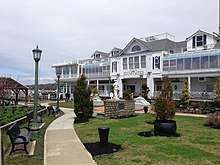

The village of Port Jefferson was incorporated in 1963.[17] The revitalization of Lower Port Jefferson soon followed as local tourism brought increased revenues and the village adjusted itself to its new economic role. One such transformation was the 1976 redevelopment of the defunct Mather & Jones Shipyard into a shop-lined promenade known as Chandler Square.
A result of the transition is new public access to much of the waterfront, as several industrial lots had previously stood in the way. Danfords Hotel and Marina was one major waterfront project, which integrated several new and historical structures into a luxury hotel. Danfords includes a commercial marina and walkable pier, marking an aspect of the harbor's transformation from industrial to recreational use.
Harborfront Park, a project completed in 2004, similarly transitioned the site of a shipyard turned Mobil Oil terminal into a public park with picnic grounds, a seasonal ice skating rink and a promenade.[18] Concurrent to the park's construction was the rebuilding of a former shipyard warehouse into the Port Jefferson Village Center, a new public space for events and recreation.
A number of historic buildings were included in the Port Jefferson Village Historic District, listed on the National Register of Historic Places in 2005.[19] Separately listed are the Bayles Shipyard and First National Bank of Port Jefferson building.[19]
Geography
The village of Port Jefferson is located on the North Shore of Long Island, 60 miles east of New York City.
The village's commerce is divided into two centers that lie one mile apart along Main Street and at differing elevations. These are known as Lower Port Jefferson and Upper Port Jefferson, respectively the waterfront and the railroad station sections of town. The first is currently the center of tourism, while the latter is undergoing plans for revitalization to the economic viability of its historic self. Further from Main Street, the remainder of Port Jefferson consists of several residential neighborhoods defined by the hills on which they sit. In the northeastern corner of the village is the neighborhood of Harbor Hills. This neighborhood occupies the western edge of Mount Sinai Harbor and contains the Port Jefferson Country Club at Harbor Hills. Brick Hill is the neighborhood directly west of the Lower Port Jefferson commercial center and was first developed by the noted circus owner P. T. Barnum. West of Upper Port Jefferson is Cedar Hill, which is topped by the c. 1859 Cedar Hill Cemetery where residents formerly would bask while enjoying views over the village from its highest point.
Within Port Jefferson is Port Jefferson Harbor, a natural deepwater harbor. Setauket Harbor branches off to the west from the harbor. One notable geographic feature is The Cove, a small cove dredged in the early 20th century by the Seaboard Dredging Company. The original name was Seaboard Hole, but it was changed for the sake of appealing to tourists, and several large sand dunes artificially created by the dredging can also be found here.
Transportation
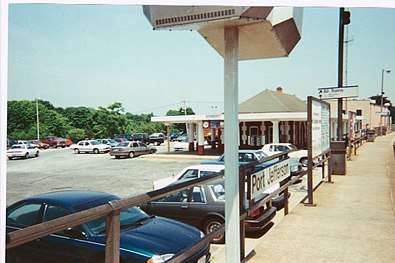
Port Jefferson features a major ferry route, a Long Island Rail Road terminus, multiple bus lines, and an extensive network of roads.
The Bridgeport & Port Jefferson Ferry is one of two routes connecting Long Island to New England. The other route is the Cross Sound Ferry at Orient Point and no bridges or tunnels exist despite past proposals. Port Jefferson's ferry company was established in 1883 and was championed by influential circus owner P. T. Barnum. Barnum, who owned lands in both Port Jefferson and Bridgeport, Connecticut, became the new company's first president.[20]
The village additionally serves as the eastern terminus for the Long Island Rail Road's Port Jefferson Branch. The branch consists of a diesel train that connects to the electrified Main Line at the village of Huntington. During the full run it continues toward the western termini of Pennsylvania Station in Manhattan or to Atlantic Terminal in Brooklyn. The average commute from Port Jefferson to Manhattan via the Long Island Rail Road takes approximately 2 hours. Train service to New York City first reached Port Jefferson in 1873. The ferry terminal and train station are approximately one mile apart. In March 2014, mayor Margot Garant announced interest in establishing a future shuttle to link the two transportation networks as well as their respective sections of town, lower and upper Port Jefferson.[21]
Port Jefferson's main street forms a section of New York State Route 25A, a scenic and historic route through Long Island's North Shore from the New York City borough of Queens eastward to Calverton. Just southeast of the village is the eastern terminus of New York State Route 347, a multilane divided highway that connects to the Northern State Parkway in Hauppauge. New York State Route 112, an important north–south route, begins just south of the village and runs to Patchogue, with a dedicated bicycle lane along much of the route.
Culture
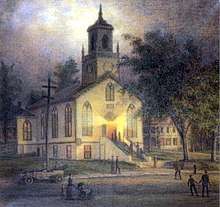
Port Jefferson has been home to the annual Port Jefferson Village Dickens Festival every year since 1996. The festival celebrates the works and times of English novelist Charles Dickens. It takes place during a weekend early in December and typically includes many events and occurrences, such as the regular sighting of people who dress in 19th century clothing, house tours, the reading of winter-related poetry, caroling, and booths set up by local businesses. Students from the Port Jefferson Middle School and High School submit poetry and art that are used in the festival. Free concerts of seasonal music by various ensembles are presented at the Methodist church. Many small festivals are held during the summer, showcasing music and crafts. Each Fourth of July sees a substantial parade on Main Street. The village also hosts an annual outdoor concert series and film screenings, both of which currently take place in Harborfront Park throughout July and August.
Port Jefferson is home to Theatre Three, a non-profit theatre company founded in 1969. Each year Theatre Three stages four musicals and two plays and additionally performs A Christmas Carol during the annual Dickens Festival. Theatre Three is held in Athena Hall, a performance space dating to 1874. The village was home to two notable landscape painters in the late 19th century, William Moore Davis and Leon Foster Jones. Both artists produced numerous depictions of Port Jefferson and its harbor. They were the subject of a 1993 art exhibition by the Long Island Museum in Stony Brook.
In keeping with its seafaring heritage, Port Jefferson hosts its own annual boat race series known as the Village Cup Regatta, with proceeds benefiting cancer research. The village also boasts two recent America's Cup winners. Bowman Scott Vogel lost the 1983 race and won the 1987 race, and pitman Wally Henry won the race in 1992.
Demographics
| Historical population | |||
|---|---|---|---|
| Census | Pop. | %± | |
| 1880 | 1,724 | — | |
| 1890 | 2,026 | 17.5% | |
| 1970 | 5,515 | — | |
| 1980 | 6,731 | 22.0% | |
| 1990 | 7,455 | 10.8% | |
| 2000 | 7,837 | 5.1% | |
| 2010 | 7,750 | −1.1% | |
| Est. 2019 | 8,145 | [3] | 5.1% |
| U.S. Decennial Census[22] | |||
As of the 2010 United States Census, there were 7,750 people, 3,090 households, and 1,975 families residing in the village. The population density was approximately 2,500 people per square mile (980/km2). The racial makeup of the village was 88.5% White, 1.6% African American, 0.2% Native American, 6.1% Asian, 2.2% from other races, and 1.4% from two or more races. Hispanic or Latino of any race were 6.5% of the population.[2]
There were 3,090 households, out of which 27.8% had children under the age of 18 living with them, 52.2% were married couples living together, 8.0% had a female householder with no husband present, 3.8% had a male household with no wife present, and 36.1% were non-families. 28.3% of all households were made up of individuals living alone, and 9.0% consisted of people living alone who were 65 years of age or older. The average household size was 2.40 and the average family size was 2.96.[2]
In the village, the population was spread out, with 20.7% under the age of 18, 6.9% from 18 to 24, 24.2% from 25 to 44, 31.2% from 45 to 64, and 16.8% who were 65 years of age or older. The median age was 43.6 years. For every 100 females, there were 97.6 males. For every 100 females age 18 and over, there were 95.1 males.
In the 2008–2012 American Community Survey, the median income for a household in the village was $108,060 and the median income for a family was $138,984. The per capita income for the village was $51,937. 6.5% of the population were below the poverty line.
Education
The Port Jefferson Union Free School District covers Belle Terre and most of Port Jefferson. In 2008, the district had 1375 students.
There are three schools:
- Edna Louise Spear Elementary School (Pre-K to 5th), also known as Port Jefferson Elementary School or Scraggy Hill School.[23]
- Port Jefferson Middle School (6th to 8th)[24]
- Earl L. Vandermeulen High School (9th to 12th), also known as Port Jefferson High School
- Port Jefferson Middle School and High School currently share the same building located on 350 Old Post Road. The Middle School (7th and 8th grade only) was previously located at 118 Spring Street. That building currently houses the Jefferson Academic Center,[25] a vocational school operated by Eastern Suffolk BOCES.[26]
The Port Jefferson "Royals" compete in Section XI athletics.
Port Jefferson union free school district (UFSD) is bordered on the west by Three Village Central School District, on the south by Comsewogue School District, and on the east by Mount Sinai School District.
Media
- Newsday (daily)
- The Port Times Record (weekly)[27]
- The Statesman (Stony Brook University)
- The Stony Brook Press (Stony Brook University)
In popular culture
- In season two of Netflix's House of Cards there are ongoing negotiations regarding the financing of a bridge from Port Jefferson to Milford, Connecticut.[28] It is referred to in the series as the "Port Jefferson Bridge". The idea is similar to many proposals that have been made over the years, collectively called the Long Island Sound link, including one project proposed from Port Jefferson to Bridgeport, Connecticut.
- Port Jefferson's Main Street and East Main Street were featured as part of National Public Radio's "Mapping Main Street" project in spring 2010.[29]
- Foghat owned a recording studio called Boogie Motel on Main Street; their 1979 album Boogie Motel was recorded there.
- The 2015 film True Story was filmed in part on the docks behind Danford's Hotel.[30][31]
Notable people
- Walter Berndt (1899–1979), cartoonist, best known for his long-run comic strip, Smitty[32]
- John Buscema (1927–2002), comic book artist[33]
- Robert Farrar Capon (1925–2013), American Episcopal priest, author and chef. Full-time parish priest in Port Jefferson for almost 30 years.
- Vic Carapazza (born 1979), Major League Baseball umpire; born in Port Jefferson[34]
- Vivien Cardone (born 1993), actress; born in Port Jefferson[35]
- Ted Chiang (born 1967), speculative fiction writer; born in Port Jefferson[36]
- Chris Colmer (1980–2010), American football offensive lineman[37]
- Leslie Davis, Armenian Genocide witness, diplomat, and author
- William Moore Davis, painter
- Tony DePhillips, Major League Baseball catcher with the Cincinnati Reds; resident of Port Jefferson[38]
- Cathy Downs, actress; born in Port Jefferson[39]
- Louis Edmonds, actor; resident of Port Jefferson[40]
- Peter Ferraro, former NHL hockey player; born in Port Jefferson[41]
- Les Goodman, former running back in the National Football League[42]
- Dan Gurney, American race car driver
- Adam Klein, opera singer; born in Port Jefferson
- Toby Knight (born 1955), former NBA player[43][44]
- Nick Mamatas, author
- Alan North, actor; resident of Port Jefferson[45]
References
- "2019 U.S. Gazetteer Files". United States Census Bureau. Retrieved July 27, 2020.
- DP-1 – Profile of General Population and Housing Characteristics: 2010 from the 2010 Demographic Profile Data for Port Jefferson village, New York Archived 2020-02-13 at Archive.today, United States Census Bureau. Accessed April 5, 2019.
- "Population and Housing Unit Estimates". United States Census Bureau. May 24, 2020. Retrieved May 27, 2020.
- Glowatzwrite, Elana (2012-04-19). "Port Jeff Village board unanimously approves budget". Northshoreoflongisland.com. Archived from the original on 2013-08-21. Retrieved 2012-04-27.
- "Geographic Identifiers: 2010 Demographic Profile Data (G001): Port Jefferson village, New York". U.S. Census Bureau, American Factfinder. Archived from the original on 2020-02-12. Retrieved 2012-12-21.
- "About PortJeff – The History of Port Jefferson, Long Island, New York". portjeffguide.com. Archived from the original on 2010-01-28. Retrieved 2010-02-10.
- Tooker William Wallace. The Indian Place-Names on Long Island and Islands Adjacent, with Their Probable Significations. pp. 246–247. Retrieved 2010-02-10.
- Barstow, Belle. Setauket, Alias Brookhaven. pp. 110–291.
- Pelletreau, William S (1905). A History of Long Island: from its settlement to the present time, Volume II. pp. 273–275.
- Port Jefferson Historical Society Newsletter, October 2000 to January 2001, confirmed using the ship's logs in the British National Archives.
- Bayles, Richard Mather (1874). Historical and Descriptive Sketches of Suffolk County and its Towns. pp. 223–281.
- "Port Jefferson: Ships Were King in 'Drowned Meadow'". Newsday. Archived from the original on 2004-11-24. Retrieved 2009-07-14.
- "Profile for Port Jefferson, New York, NY". ePodunk. Archived from the original on 2003-07-16. Retrieved 2012-10-04.
- Starbuck, Alexander, History of the American Whale Fishery, Originally Part 4 of the Report of the U.S. Commission on Fish and Fisheries, Washington, DC, 1878, Reprinted by Castle Books, Secaucus, NJ, 1989
- Hegarty, Reginald B., Returns of Whaling Vessels Sailing From American Ports, Old Dartmouth Historical Society, New Bedford, 1959
- Robert Maggio (2013). Images of America:Port Jefferson. pp. 65–70.
- "Port Jefferson New York". City-Data.com. Retrieved 2012-10-04.
- "Harborfront Park". Archived from the original on 2014-02-26. Retrieved 2014-05-06.
- "National Register Information System". National Register of Historic Places. National Park Service. March 13, 2009.
- "The Bridgeport & Port Jefferson ferry: History". Retrieved 2014-04-02.
- "Port Jefferson Officials Mull Village Shuttle". thelirrtoday.com. March 22, 2014. Retrieved May 13, 2019.
- "Census of Population and Housing". Census.gov. Retrieved June 4, 2015.
- Edna Louise Spear Elementary School, nysed.gov
- Port Jefferson Middle School, nysed.gov
- Google Street View 118 Spring Street
- Jefferson Academic Center, Eastern Suffolk BOCES
- "Port Times Record, North Shore of Long Island | News, Sports, Blogs, Events, Businesses & Coupon Deals". Northshoreoflongisland.com. Archived from the original on 2011-12-05. Retrieved 2012-04-27.
- "Bishop Responds to L.I. Wine Criticism on House of Cards". The Suffolk Times. Retrieved 2014-02-22.
- "Documentary: Mapping Main Street Includes Port Jeff". Patch.com. Retrieved 2014-02-22.
- "Updated: Crowds Swarm Danford's as James Franco, Jonah Hill Movie Films in Village". 18 April 2013.
- "Archived copy". Archived from the original on 2014-06-12. Retrieved 2016-03-10.CS1 maint: archived copy as title (link)
- Staff. "Walter Berndt, Drew Comic Strip Smitty, Which Ran 50 Years", The New York Times, August 15, 1979. Accessed June 5, 2017. "Walter Berndt, the cartoonist who created the comic strip Smitty, which was syndicated in hundreds of newspapers for more than 50 years, died Monday in Mather Memorial Hospital in Port Jefferson, L.I. He was 79 years old and had lived in Port Jefferson since 1937."
- Nash, Eric. "John Buscema, 74, Who Drew Classic Comic Book Characters", The New York Times, January 28, 2002. Accessed June 5, 2017. "John Buscema, a comic book artist known for his robust renditions of characters like the Silver Surfer and Conan the Barbarian, died on Jan. 10. He was 74 and lived in Port Jefferson, N.Y."
- "Vic Carapazza". Baseball-Reference.Com. Retrieved 2012-10-04.
- "Vivien Cardone". IMDb. Retrieved 2012-10-04.
- "Ted Chiang – Summary Bibliography". The Internet Speculative Fiction Database. Retrieved 2012-10-04.
- Droschak, David via Associated Press. "Colmer laments lost season", Spartanburg Herald-Journal, October 28, 2003. Accessed June 5, 2017. "When Colmer came to N.C. State from Port Jefferson, N.Y., his goal was to become a teacher, not necessarily a pro lineman."
- "Tony DePhillips Stats". Baseball Almanac. Retrieved 2012-10-04.
- "Cathy Downs". IMDb. Retrieved 2012-10-04.
- "Louis Edmonds". IMDb. Retrieved 2012-10-04.
- "Peter Ferraro". Hockey-Reference.Com. Retrieved 2012-10-04.
- "Les Goodman". databaseFootball.com. Archived from the original on 2012-05-31. Retrieved 2012-10-03.
- Liepa, Bob. "Greatest Athletes #20: Edwards, Creighton forever linked", The Suffolk Times, July 29, 2011. Accessed June 5, 2017. "Shedrick said Edwards was better than any of the players among Greenport’s opponents, which included future NBA players Toby Knight of Port Jefferson and Mitch Kupchack of Brentwood."
- Goldaper, Sam. "Irish Down St. John's On 2 Foul Shots, 68‐67", The New York Times, February 14, 1975. Accessed June 5, 2017. "Toby Knight, the powerfully built Notre Dame sophomore from Port Jefferson, L.I., stole the spotlight that was supposed to belong to Adrian Dantley last night at Madison Square Garden."
- "Alan North". IMDb. Retrieved 2012-10-04.
External links
| Wikivoyage has a travel guide for Port Jefferson. |

- Official website